
An article published in the journal “Proceedings of the Royal Society B: Biological Sciences” reports a study on specimens in an exceptional state of conservation of Gangtoucunia aspera, a primitive animal that lived during the Cambrian period, just over 500 million years ago. A team of researchers examined new fossils attributed to this species that included their soft tissues. This made it possible to study the first animals that had developed a skeleton and concluded that they were related to today’s phylum of cnidarians, in particular, the scyphozoans (class Scyphozoa), which include the larger jellyfish.
Tubicolous animals, the ones that live in a calcareous tubular exoskeleton generated by them, are common but there are few fossil traces that allow us to reconstruct their evolution. Fossils have been discovered that include only skeletons and in 1999 the species Gangtoucunia aspera was proposed. The problem is that soft tissue fossilization is particularly rare among those primitive animals, so it was difficult to get an idea of what they were like. This makes the classification of these fossils problematic.
The discovery in the Wulongqing Formation, a site in the Yunnan Province, China, of the fossils of four new specimens of Gangtoucunia aspera that include soft tissue was a great stroke of luck that led to new insights into the history of tubicolous animals. The top image (Courtesy Luke Parry and Guangxu Zhang. All rights reserved) shows one of the newly discovered specimens and a diagram illustrating various anatomical parts of this animal.
The possibility of examining practically complete specimens of Gangtoucunia aspera from the anatomical point of view made it possible to conduct a phylogenetic analysis. This means that the researchers looked at the evolutionary development of these animals that lived over 500 million years ago to establish similarities with groups of today’s animals.
According to the researchers, Gangtoucunia aspera looked similar to certain modern-day jellyfish of the scyphozoan class. One difference is that this animal’s tubular skeleton was made of calcium phosphate, a mineral that makes up the bones and teeth of animals such as mammals but not so many other animals today.
The anatomical features of Gangtoucunia aspera also show the differences with respect to annelids. The specimens that included only the exoskeleton had left open the possibility of a kinship with the annelids. That’s because mineralized tube fossils have been found belonging to annelid species that generated them. But now the availability of much more complete fossils proves that this animal was related to the cnidarians and not to the annelids.
Fossils of many tubicolous animals from the Cambrian indicate that they had become increasingly common during that geological period. The extraordinary diversification that led paleontologists to talk about a Cambrian explosion may have created evolutionary pressure that among other things made tubicolous animals more difficult to prey upon. This diffusion and the rarity of fossils that include soft tissues make their study difficult, so the discovery of extraordinarily preserved specimens was a great stroke of luck.
Reconstructing the evolutionary history of animals composed mainly of soft tissues such as jellyfish is very difficult because those tissues only fossilize under particular conditions. This study shows precisely the importance of discovering these lucky cases that help to classify certain very ancient species.


